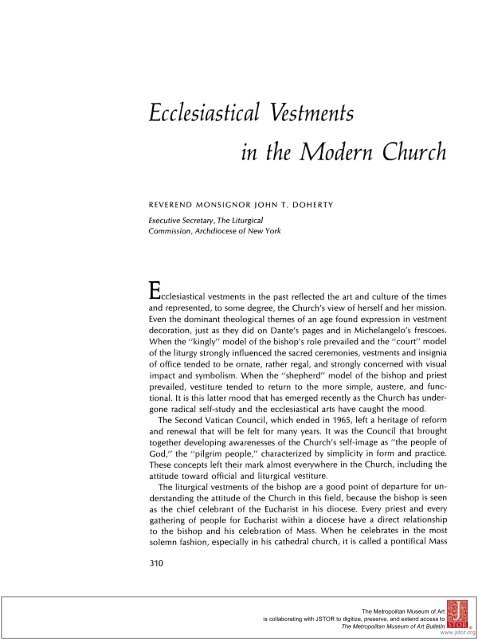The Metropolitan Museum of Art Bulletin, v. 29, no. 7 (March, 1971)
The Metropolitan Museum of Art Bulletin, v. 29, no. 7 (March, 1971)
The Metropolitan Museum of Art Bulletin, v. 29, no. 7 (March, 1971)
Create successful ePaper yourself
Turn your PDF publications into a flip-book with our unique Google optimized e-Paper software.
Ecclesiastical Vestments<br />
in the Modern Church<br />
REVEREND MONSIGNOR<br />
JOHN T. DOHERTY<br />
Executive Secretary, <strong>The</strong> Liturgical<br />
Commission, Archdiocese <strong>of</strong> New York<br />
Ecclesiastical vestments in the past reflected the art and culture <strong>of</strong> the times<br />
and represented, to some degree, the Church's view <strong>of</strong> herself and her mission.<br />
Even the dominant theological themes <strong>of</strong> an age found expression in vestment<br />
decoration, just as they did on Dante's pages and in Michelangelo's frescoes.<br />
When the "kingly" model <strong>of</strong> the bishop's role prevailed and the "court" model<br />
<strong>of</strong> the liturgy strongly influenced the sacred ceremonies, vestments and insignia<br />
<strong>of</strong> <strong>of</strong>fice tended to be ornate, rather regal, and strongly concerned with visual<br />
impact and symbolism. When the "shepherd" model <strong>of</strong> the bishop and priest<br />
prevailed, vestiture tended to return to the more simple, austere, and functional.<br />
It is this latter mood that has emerged recently as the Church has undergone<br />
radical self-study and the ecclesiastical arts have caught the mood.<br />
<strong>The</strong> Second Vatican Council, which ended in 1965, left a heritage <strong>of</strong> reform<br />
and renewal that will be felt for many years. It was the Council that brought<br />
together developing awarenesses <strong>of</strong> the Church's self-image as "the people <strong>of</strong><br />
God," the "pilgrim people," characterized by simplicity in form and practice.<br />
<strong>The</strong>se concepts left their mark almost everywhere in the Church, including the<br />
attitude toward <strong>of</strong>ficial and liturgical vestiture.<br />
<strong>The</strong> liturgical vestments <strong>of</strong> the bishop are a good point <strong>of</strong> departure for understanding<br />
the attitude <strong>of</strong> the Church in this field, because the bishop is seen<br />
as the chief celebrant <strong>of</strong> the Eucharist in his diocese. Every priest and every<br />
gathering <strong>of</strong> people for Eucharist within a diocese have a direct relationship<br />
to the bishop and his celebration <strong>of</strong> Mass. When he celebrates in the most<br />
solemn fashion, especially in his cathedral church, it is called a pontifical Mass<br />
310<br />
<strong>The</strong> <strong>Metropolitan</strong> <strong>Museum</strong> <strong>of</strong> <strong>Art</strong><br />
is collaborating with JSTOR to digitize, preserve, and extend access to<br />
<strong>The</strong> <strong>Metropolitan</strong> <strong>Museum</strong> <strong>of</strong> <strong>Art</strong> <strong>Bulletin</strong> ®<br />
www.jstor.org

















